The Ultimate Guide to Getting an Internship at a Startup

This article was contributed by Brian Tan, a former Kalibrr intern. It was originally published on Medium.
If you don’t know it yet, internships are incredibly important.
Any student who wants a job after college should have an internship. They’re the best way for students to boost their resume, learn real-world skills, and try out job functions they are interested in.
Moreover, most 3rd year students in the Philippines are preparing to apply for internships already for June 2018. A lot of 1st and 2nd year college students, and even high school students, are starting to look for internships as well.
As such, I thought of writing a step-by-step guide to help you land an internship, drawn from my experiences in applying and getting internships. But this is not just a guide for any internship — this is a guide on how to land one at any startup in the Philippines.
But first off, you might ask:
TOPICS
How would you define a startup?
This is a hard question to answer because there’s many different ways to define a startup.
But to define it first, let’s use the definition accepted in Silicon Valley — a startup is a company designed to grow and scale fast.
Some Examples of Startups
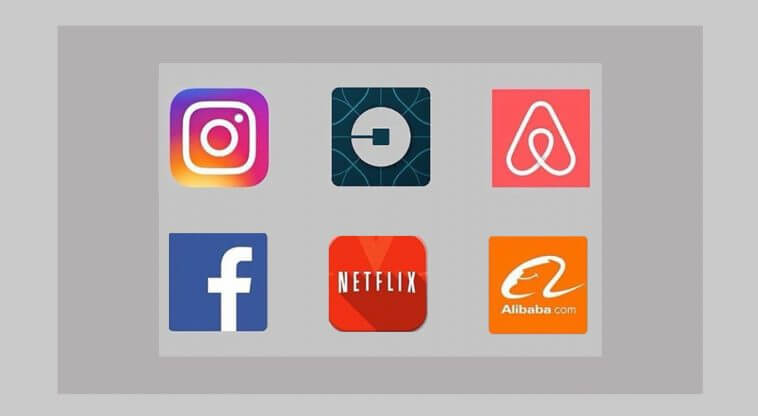
Source: Being Guru
Some examples are when Facebook, Airbnb, and Uber started. Each of these companies started with very few users, but they’ve since grown to be very big, so they technically aren’t considered startups anymore.
In the Philippines, two great examples of startups are Kalibrr and ZAP, and I’ve had the privilege of interning at both:
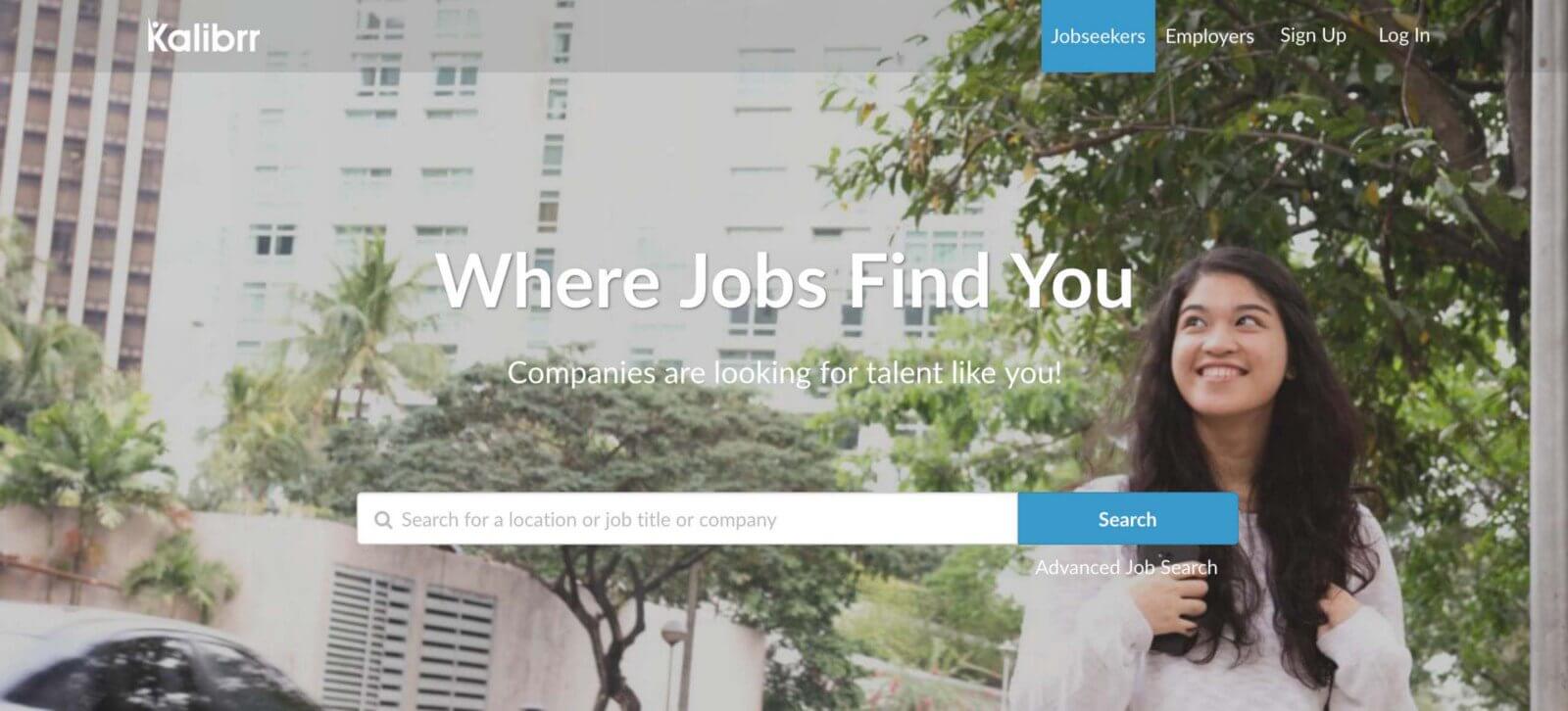
Kalibrr is an online platform that helps jobseekers find jobs and companies hire talent. It currently has over 1,000,000 active jobseekers on the platform, and it was just launched in 2013.
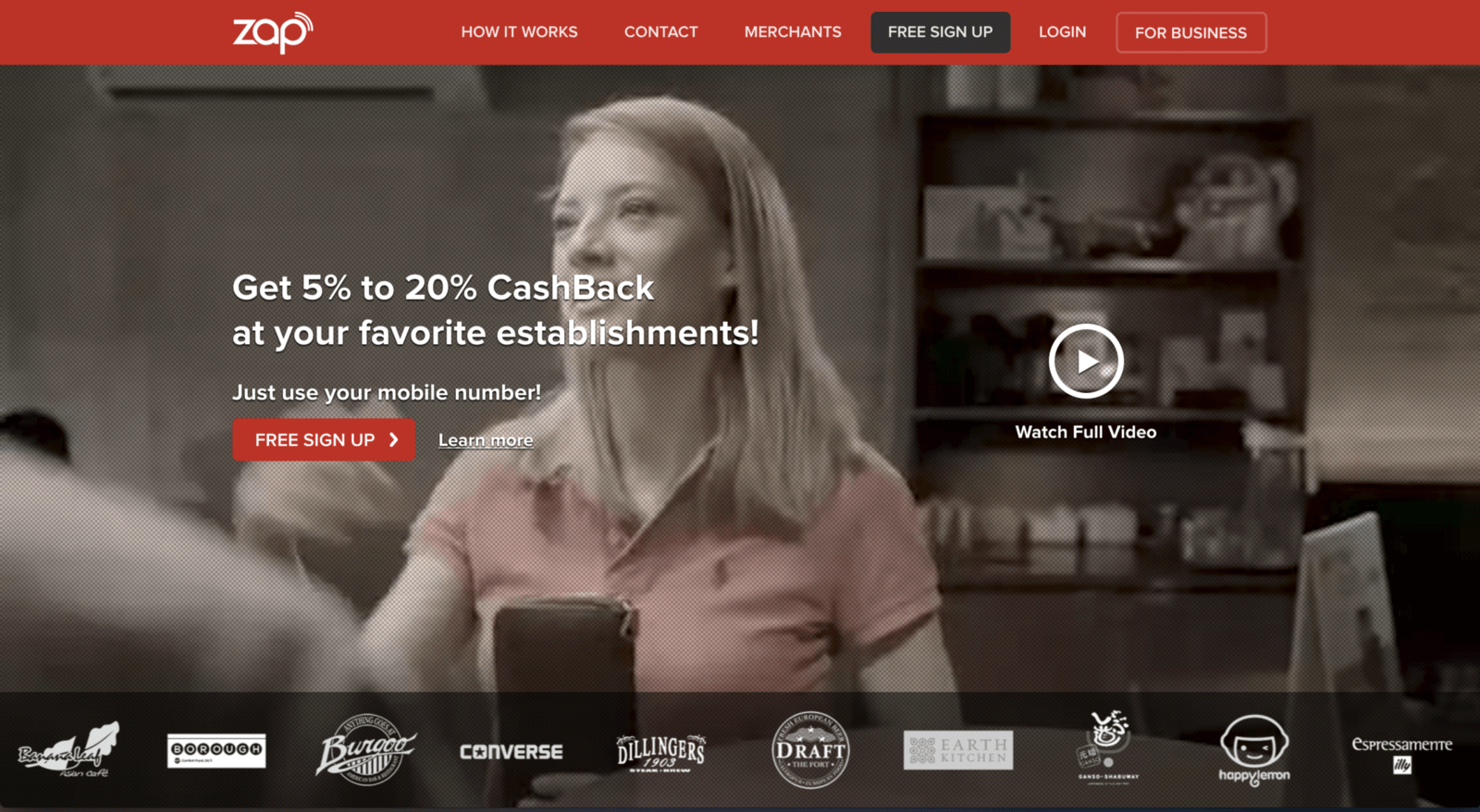
Source: ZAP
Meanwhile, ZAP is a loyalty platform that helps businesses like restaurants know their customers and reward them with points. It has over 800 partner businesses already in the Philippines in less than 5 years.
But, let’s not limit it to these
However, since there are a lot of other companies that would be great to work for, but aren’t designed to scale fast, or are ‘big’ already, I’ll make the definition of a startup more loose for this guide.
Hence, I’ll define a startup mainly as: 1) Any company that is interesting to work for, and 2) a company that doesn’t have a formal internship program, such as the ones P&G, Unilever, and other big companies have.
So this guide applies to practically any company you find interesting, so long as they don’t have a formal internship program. I say that because companies that have formal internship programs are usually huge, and that a lot of students apply for those internships. So they’re way more competitive, and it’s harder for you to get in.
The point of this guide is to help you find interesting companies that aren’t aggressively or formally looking for interns, and to help you land an internship in them.
When I got my internships at ZAP and Kalibrr, both companies weren’t formally looking for interns, but I was still able to get in. I’m sure other students can do this too, and I’m sure other companies would love to have passionate and talented interns with them.
Why startups over corporations?
Some of you might be wondering this, so I’ll answer it here. The Philippines’ number of startups is growing every year, so there are definitely quite a lot of startups to apply to.
Also, working at startups (assuming they’re small) gives you closer access to the founders of these startups, and they‘re usually incredibly smart and inspiring people.
And although startups don’t have formal internship programs compared to those like P&G and Unilever, you’ll learn so much more because you’re given real work, and you’re really integrated to the company.
Why listen to me?
As I’ve said, I’ve been able to intern at 2 startups in the Philippines already — Kalibrr and ZAP. Both of these startups are funded by Kickstart (Globe’s venture capital arm), and it’s easy to say they are two of the most successful startups in the country.
I also know a lot of startup founders from my days organizing startup events for ASES, and I also have a lot of friends who’ve interned for different startups. So I know what founders are looking for and what it takes for students to land internships at startups.
Is this guide limited to a specific job title/function?
This guide isn’t limited to a specific job title. Whether you want to apply as a UI/UX designer, graphic designer, web developer, business dev’t officer, this guide should still apply to you.
I’ve been a sales intern and web development intern at ZAP, and I was a Product Design Intern at Kalibrr, so I do have an idea on how to apply under any of those positions.
So without further ado, let’s get started on the step-by-step guide!
Step 1: Create your shortlist of startups/companies you want to apply to
The first step in landing an internship is to know what are your options.
To do this, you definitely should create a shortlist. In this shortlist, you’ll fill it up with two kinds of startups: 1) startups that are actively hiring for interns, and 2) startups that aren’t, but you’re highly interested to work for.
To fill list #1 (startups actively hiring for interns), it’s pretty straightforward.
Method #1: Search on Job Portals like Kalibrr
The easiest way is to go on Kalibrr.com and just search ‘intern’ among their list of open jobs. When I last searched, there were 952 job matches to the ‘intern’ search term. But it’s up to you to discern if any of these companies you find are interesting to work for or not.
Method #2: Join These Facebook Groups
Another way is to find the ‘Jobs and Internships’ Facebook group of your university. For Ateneo, ours is called Ateneo Jobs and Internships, and lots of people post their about companies looking for interns from time to time. There should be a similar Facebook group for UP, UST, and DLSU too.
You should also join the Startup PH: Jobs, Startup Philippines: Internships and Startup PH Manila: Internships Facebook groups to find startups actively hiring interns. There’s also this FB group that has job posts looking for designers and web developers.
After going through the job portals and these Facebook groups, make sure you compile a list of all these companies and their job postings. You can either copy paste or screenshot these job posts into a Google Doc or Word file.
You could also compile them all in an Evernote notebook, especially with the Evernote Web Clipper chrome extension, which is what I do.
Now, for the companies that aren’t actively hiring
So let’s say you’ve finished your search, and you haven’t really found a company you absolutely want to work for. That’s okay too.
A lot of startups aren’t actively hiring interns, and that’s because they usually don’t need interns. It takes work for startups to find, hire, and train an employee, so they’d usually rather hire a full-time employee than an intern.
So where do you find startups that aren’t actively hiring, but are interesting to work for?
You can start by looking at Kickstart’s portfolio of startups. I can’t say all of them are interesting, but most of them should be interesting to work for.
You can also look at the recent Ideaspace startups. Ideaspace is a startup incubator owned by Smart/PLDT. One batch of startups just concluded, so you can find a list here.
You could also check this list of top startups in the Philippines.
How do I know if a startup is worth working for?
It’s best to do your homework on each company first, and find out if they’re good to work for or not. Here’s some questions to find answers to to know if a company is worth applying to:
- Do I understand what their startup does? Is it interesting to me?
- Do I understand what their product is? Has it launched?
- How many people work here? Do they have an office address?
- Does the company have articles about them in Google? Have they been funded? Have they reached any milestones lately?
Generally, you’d want to make sure that you’re working for a startup that has 1) been around for a year; 2) has at least five people; 3) has a beta of their product at least, and 4) has an office or co-working space where they work at.
Startups that don’t fulfill this standard are probably still figuring things out and might even close down, so it’s best to make sure you find a startup that fulfills the criteria I listed above.
Step 2: Narrow down your shortlist
Now that you’ve made a shortlist, it’s now time to narrow down your shortlist in list #1 (startups actively hiring) and #2 (startups not actively hiring).
For list #1, it’s simple. Just rank the startups based on which ones you’re most interested to work for. This is where you’ll weigh all the research you made above and reflect on which company you think is most exciting to work for.
If you want to learn more about what a company is like, you have two main options:
Option 1: Get in touch with one of the founders/employees
If the startup has a website, chances are they have a team page, and you’ll find the names of the founders or employees there. With that, you can just search them on Facebook or Linkedin (better if you have an account already). After searching them, you can just cold-message (or cold email them if their emails are in the website).
Here’s a sample message script you can use:
Hi [insert startup founder’s first name]!
This is Brian Tan, a 3rd year IT Entrepreneurship student from the Ateneo De Manila University. I’m looking to get an internship in June 2018, and I’m considering interning in your company.
I’m thinking of interning in your company because of [insert some flattering remarks about why you’re deeply interested in their company].
As such, I just have two questions I’d love for you to answer first: 1. Are you open to hiring a [insert what kind of intern you want to be there] from June to Aug 2018? and 2. What’s it like working at your company?
Thanks! 🙂
Feel free to tweak that accordingly depending on who you’re messaging. If you’re messaging an employee, then obviously you have to tweak the message a bit more.
Option 2: Find students who’ve interned there before
In case you’re a bit scared to do option 1, then the easier option is to do option 2. However, some startups might not have had students who’ve interned there before. To do this, you can try searching on Facebook, Google, and Linkedin.
There’s a chance that a student who’s interned at a startup before made a public post about interning there. Or you could find someone who put it on their Linkedin profile.
Here’s a sample message script you can use:
Hi [insert student’s first name]!
I’m Brian Tan, a 3rd year IT Entrepreneurship student from the Ateneo De Manila University. I saw that you interned at [insert startup’s name] last ___. I’m thinking of interning there as well, but I’d love to ask you a few questions first, if that’s okay with you!
I’d just like to to ask: 1. How was your experience interning at [insert startup’s name]? and 2. Would you recommend I intern there as a [insert job function you want to intern there as]
Thanks so much! 🙂
Step 3: Find a contact in these startups
Cold-messaging or cold-emailing people isn’t just good for doing research for a certain company, but they’re also good methods for finding contacts in startups and getting in touch with them.
Why find a contact? It’s best to find a contact in the startup you’re applying for because they will make it easier for you to get an interview.
Back when I was applying for my first internship, I actually applied to ZAP through their general email, winners@zap.com.ph. Here’s the email I sent them:
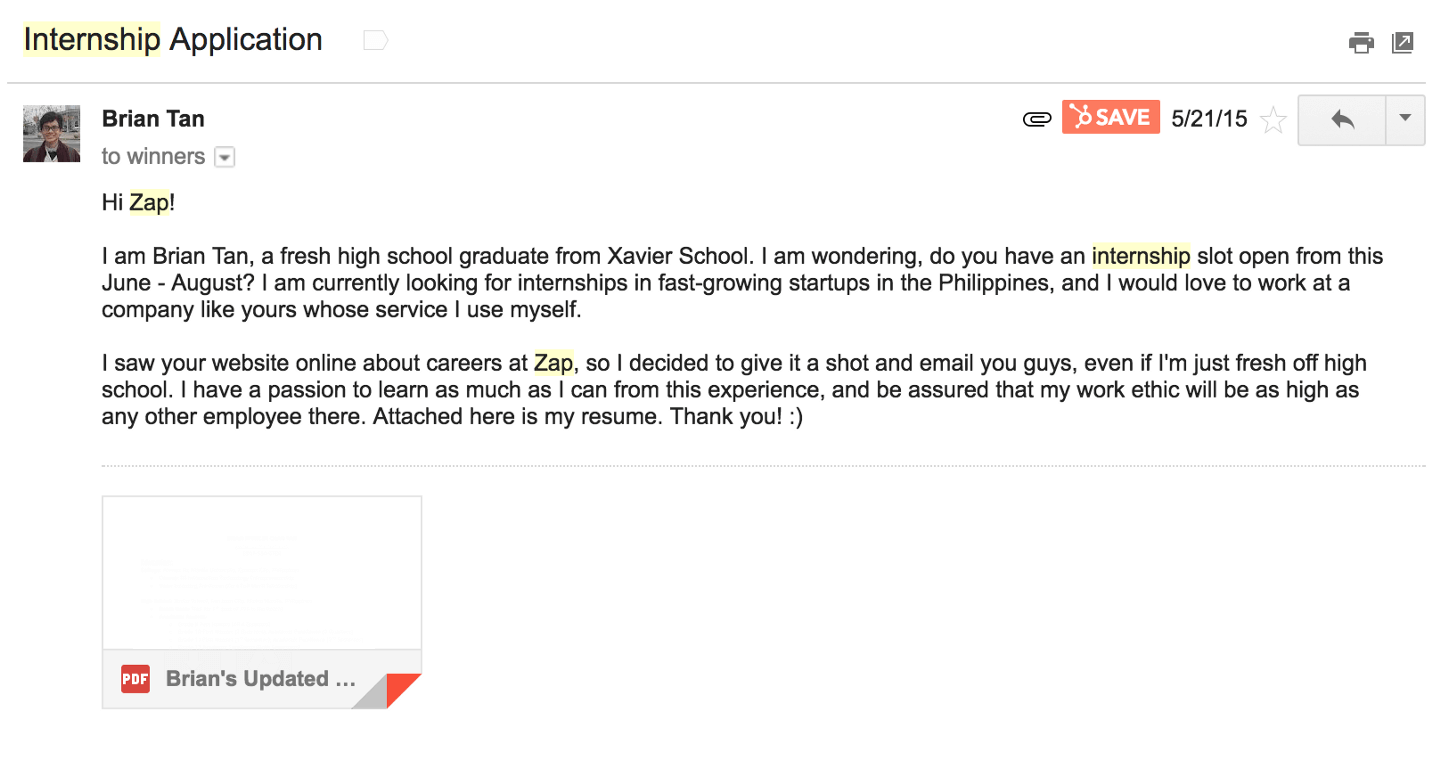
I also emailed Coins.ph:
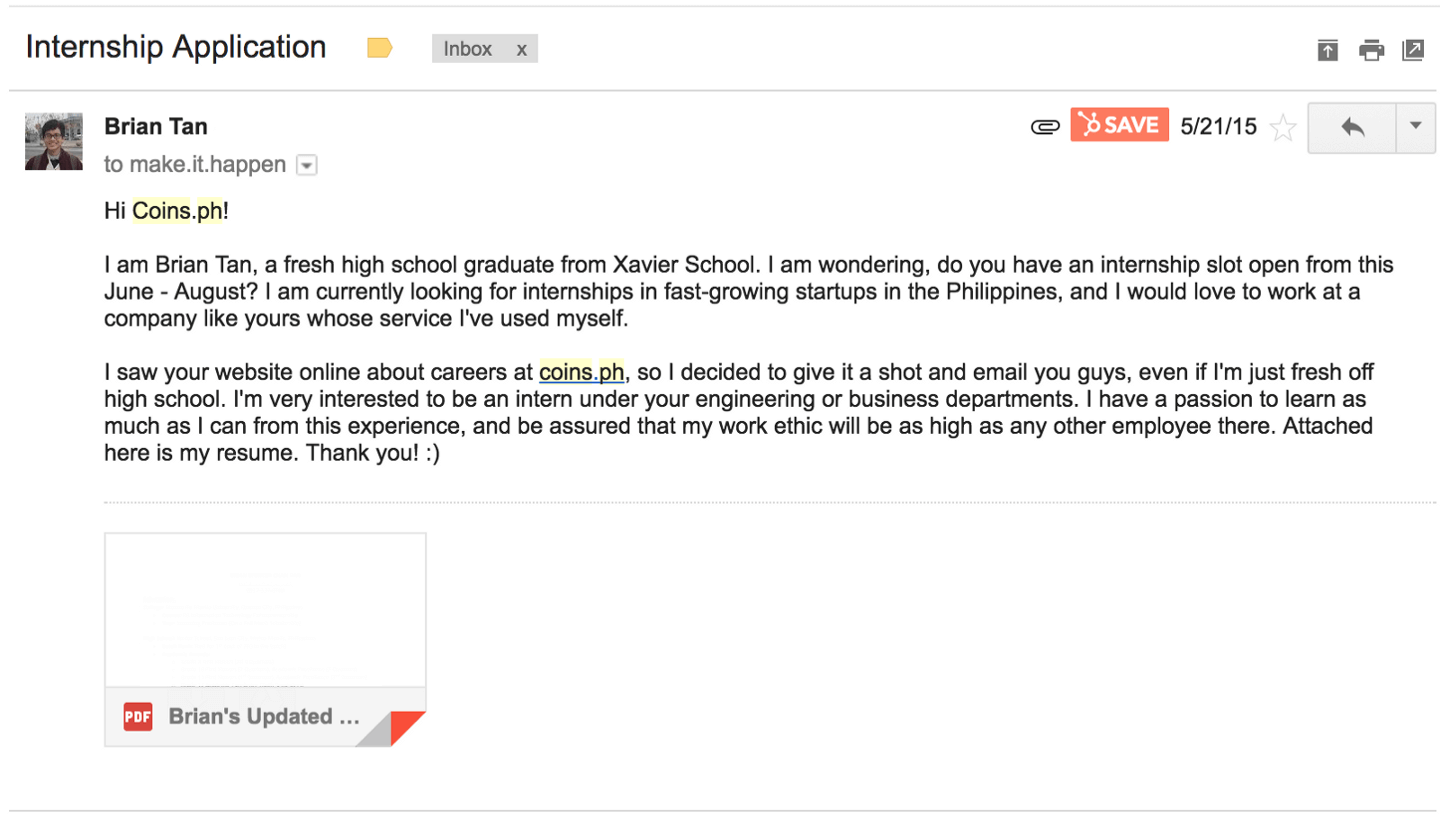
Neither of them replied back to me. But thankfully, my friend Jaime knew one of the co-founders of ZAP, and he sent an email introducing me to him. That’s how I was able to get him to interview me and accept me. I also got my interview and internship at Kalibrr through asking a friend I made there.
Other ways to meet contacts in startups:
Aside from cold-messaging or cold-emailing though, there’s other ways to meet contacts who can help you get internships. Here’s a few ways:
- Join startup conferences and events — To do this, just keep updated with the posts in the Startup PH FB group. There’s always new conferences and events there, and a lot of them are free to join. I’ve been to quite a few, and I’ve networked with a lot of startup founders and employees through them. Don’t be intimidated — it’s okay for students to join these networking events! They’ll be happy to see younger faces there.
- Join more Facebook Groups — There’s also other Facebook groups where employees at startups are in aside from the ones I mentioned above. One example is Product PH, a Facebook group where a lot of product managers in the Philippines are part of. Another is UX Philippines, where a lot of designers in startups are part. Then just look at the profiles of some of the people who post and comment to see what startups they’ve worked at.
After finding contacts at startups you want to intern for, it’s time to move to step 3:
Step 4: Create and perfect your resume and Linkedin profile (if you haven’t yet)
Now that you’ve made your shortlist and found some contacts, it’s time to create and perfect your resume and Linkedin profile.
Any startup you apply to will ask for your resume, so it’s best you make one that will impress whoever is reading it. My school, Ateneo, has a resume format that most Ateneans follow, and I’ve linked it below for you to download:
Here’s the guide to writing one, made by Ateneo. And here’s a sample resume (in docx format, for you to edit).
However, I personally don’t follow Ateneo’s resume template, mainly because I don’t want my resume to look like any other Atenean’s resume. So if you wanted to set yourself apart, here’s a few things that can make your resume more unique:
1. Put a Short Bio or Summary at the Top
Instead of listing out which career fields/industries you’re interested to work for (usually you’ll see Ateneans with 2–3 industries there), you can put a short bio instead. For example, if you’re applying for a marketing internship, you could put there “I’m an Atenean junior who’s deeply passionate about marketing and interested to pursue a long-term career in it.”
Even though it’s unusual, it shows to the recruiter you know what you want to do and that you’re different than others. Another way is to put there a summary of your resume at the top, such as “Atenean junior with 1.5 years of experience in marketing and finance roles for my orgs. Currently looking for a marketing internship to apply my skills in marketing.”
2. Design Your Resume
If you have an eye for design or know how to use design software like Photoshop, Canva, or Sketch, then you should design your resume. You’ll instantly set yourself apart from other people and make a good impression on the startup. This is especially important for people applying for graphic design or UX design internships.
Step 5 (optional): Are you a designer or software developer? Make a portfolio.
Most startups in the Philippines are looking for designers or software developers as interns. After all, most startups here are developing websites or apps, so they’d need people to design the website or collaterals for it, or they’d need developers to help code and improve their product.
So if you’re looking to apply as a designer or developer, it’s important you have a portfolio. For designers, a portfolio can just be a PDF file where you compile 3–5 case studies of design work you’ve done. You can describe what each project was for and show your process and designs.
Meanwhile, for developers, you can just put together a list of links of websites or apps you’ve tried to develop, and send them over to the startup.
If you want your portfolio to be more presentable though, I’d recommend you make one here on Medium. You can do so by making a publication and putting ‘stories’ under those publication, and each story can be one project in your portfolio. You can check out mine as an example here.
Step 6: Apply!
Now that you’ve prepared everything, from making a shortlist, to researching about the startup and finding contacts, to preparing your resume and Linkedin profile, now it’s time to apply. If you’re applying through Kalibrr or Jobstreet or through a formal job post, then just fill up the app form and send in the necessary requirements.
But if you’re applying for a startup that isn’t actively hiring, then it’s all about your email to them. Here’s what you could use for that email:
“Hi [Insert Startup Employee’s Name/Startup’s Name]!
I’m [insert name], a [insert year level and course] student from [school name]. I’m emailing you because I want to apply as a ____ intern at your company.
I’ve had [insert relevant experience 1, 2, and 3,]. I’d also love to learn more about working in a startup and about [insert internship field] while there. I’m deeply interested in your startup because of [insert reason why you’re interested]. Attached below is my resume. Looking forward to your reply!”
You can tailor this email script to your liking, but the important thing is you show these three things:
- Passion and interest for what the startup does (mention it in your email script)
- Experience and/or interest in the field you want to intern in, and
- Your resume.
Step 7: Wait for them to schedule an interview with you, then prepare for it!
If you’ve gotten this far, then congratulations! You’ve made it farther than most students, because a lot of startups might just ignore your emails. You can follow up though with your contact or with the startup’s email around 2 times before giving up. But assuming you get this far, then you can now prepare for an interview.
The best way to prepare for an interview is to know what questions will be asked. The best way to know what questions will be asked is to research online about it, such as “UX Design Interview Questions” or “Digital Marketing Interview Questions”. If you find a question you think will be asked, but haven’t prepared for, then list those down.
Here are some questions interviewers typically ask (regardless of field), and I think everyone should prepare for them (it also helps you know yourself more by answering them):
- Tell me about yourself.
- Why are you interested to work here?
- Why are you interested to be a ____ intern?
- What relevant experience do you have for this internship?
- What resources did you use to learn this field?
- How would you define (insert field name)?
- What are your strengths? What are your weaknesses?
- What do you want to do or work on if you work here?
There are a lot more common questions than these, but you can just think of them on your own. These are questions I’ve been asked when I was interviewed at ZAP and Kalibrr.
After listing down those questions, now it’s important to practice answering them. You can do this by filming yourself on your webcam/phone to check what you look and sound like. It’s important to make your answers not too long and not too short, and to start and end well. Try to sound confident and impressive, but don’t try to exaggerate or make up things either.
Step 8: Wait for your result. Rejected? It’s okay. Accepted? You can celebrate!
After your interview, it usually takes 1–2 weeks for you to get a result. In case you haven’t gotten a result within 2 weeks, then you can just follow up with your interviewer for the result.
If you get rejected, then it’s okay. Don’t take it personally. Fail fast, fail forward. You can ask your interviewer why they rejected you and ask what you should do so you can be accepted the next year (or in the future).
If you get accepted, then you can celebrate! All your hard work has paid off. But before you celebrate, make sure you ask all the details about your internship first, such as:
- The start date and end date of the internship
- How often you have to be at the office, and from what time to what time
- Ask if you’ll be paid or not. Try to ask for a salary or stipend if you can, even just something like P4,000 a month. This will help you cover transpo and food costs while interning.
- Know what your job description and responsibilities are. Do they sound interesting, and will you learn while doing them?
It’s important to ask these so you know what you’re getting into. Make sure it’s clear that the internship they’re offering you is something you can handle and want to take.
That’s It!
So there you have it, that’s my 8-step guide to landing an internship at any startup. BUT, it’s not enough to just read this guide. 90% of you who read this guide will just read it and not do any of the steps here.
If you really want to get an internship at a startup, you should really do the steps and tips in this article. Bookmark this, or save it on Pocket/Evernote, and remind yourself to follow it when you start applying.
Whether it’s joining those startup-related FB groups, fixing up your resume and showing it to someone, or cold messaging startup founders and employees, these are the keys to letting you get an internship at a startup. You’d be at a disadvantage not following them.
If you have any questions or comments about my guide, feel free to comment below! I’d love to hear what your issues are at any of the steps, or if you agree/disagree with any of the points I made here. Anyway, good luck in finding your internship! I wish you the best.






No comment available yet!